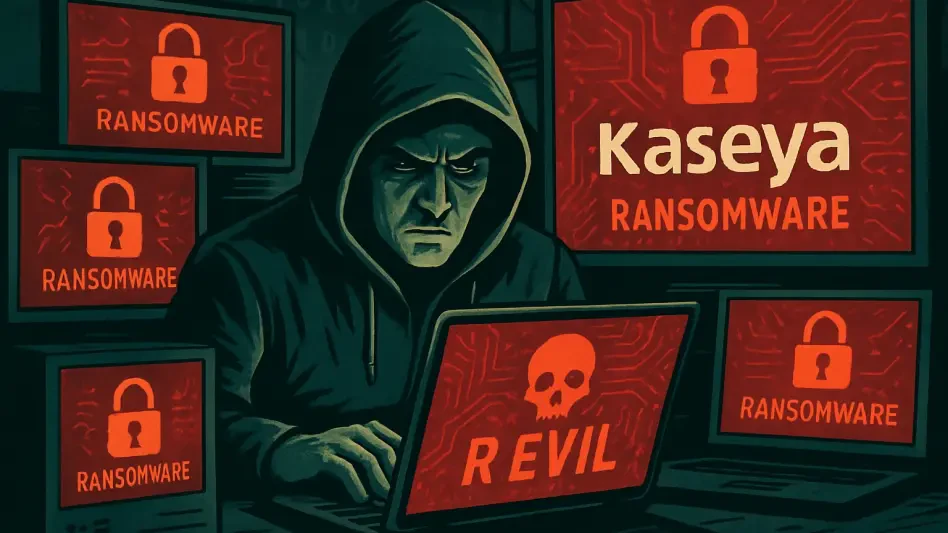In the shadowy realm of cybercrime, few entities have instilled as much fear and disruption as REvil, a notorious ransomware-as-a-service (RaaS) group that has left a trail of digital devastation across the globe, emerging as a dominant force in the underworld of hacking. REvil’s meticulously organized operations have targeted major corporations and critical infrastructure alike, with the spotlight falling on the catastrophic 2021 Kaseya supply chain attack, a pivotal event that exposed the vulnerabilities of interconnected systems on an unprecedented scale. Adding a layer of intrigue to this already gripping narrative is the explosive claim from Yaroslav Vasinskyi, a convicted REvil affiliate, who alleges that the Russian government itself orchestrated the Kaseya assault. This revelation, shared during a DEF CON 33 session on August 9, raises chilling questions about state-sponsored cyber warfare. This article delves into REvil’s rise, the mechanics of the Kaseya incident, Vasinskyi’s startling accusations, and the broader implications for global cybersecurity in an era of escalating digital threats.
Unpacking REvil’s Ascent in Cybercrime
The story of REvil begins in 2019, when it rose from the remnants of the GandCrab ransomware operation to become a leading name in the RaaS model. Structured like a corporate entity, the group was led by a tight-knit core of five administrators who oversaw approximately 40 affiliates, each rigorously vetted to ensure loyalty and competence. What set REvil apart was its innovative approach—dedicated communication platforms for seamless coordination, data leak sites to intensify pressure on victims, and stable malware that guaranteed decryption upon ransom payment. Their meticulous accounting systems further ensured fair distribution of profits, fostering trust within their illicit network. This professionalization of cybercrime marked a disturbing evolution, transforming disorganized hackers into a streamlined criminal enterprise capable of executing large-scale attacks with precision and efficiency.
REvil’s growing influence was evident in high-profile attacks on global giants like Acer and JBS S.A., demonstrating their ability to target organizations with vast resources and international reach. By outsourcing specialized tasks such as money laundering, the group maintained operational agility while focusing on core attack strategies. This business-like model not only maximized their impact but also set a dangerous precedent for other ransomware groups, signaling a shift toward more sophisticated and structured cyber threats. The success of REvil highlights a critical challenge for cybersecurity experts: combating an enemy that operates with the discipline and strategy of a legitimate corporation, blurring the lines between crime and enterprise in the digital age.
The Kaseya Incident: A Devastating Supply Chain Breach
Turning to the pivotal event of July 2021, the Kaseya attack stands as a stark reminder of the fragility of modern digital ecosystems. Kaseya, a provider of remote IT management software, became the entry point for REvil’s assault through a vulnerability in its VSA platform. This supply chain breach had a cascading effect, disrupting over 1,000 companies worldwide and impacting critical infrastructure in ways that reverberated across industries. Unlike direct attacks on individual entities, this incident showcased the exponential damage possible when a single point of failure is exploited, amplifying the reach of ransomware to an alarming degree. The scale of disruption prompted urgent calls for stronger defenses against such vulnerabilities, as businesses realized their reliance on interconnected systems could be their greatest weakness.
Beyond the immediate chaos, the Kaseya attack exposed a growing trend in cybercrime: the targeting of supply chains as a means to maximize impact. By striking at a widely used software provider, REvil demonstrated how attackers could infiltrate countless downstream organizations through a single exploit. This strategy not only increased the likelihood of ransom payments due to the sheer number of affected parties but also highlighted the urgent need for comprehensive security measures across entire supply networks. Governments and private sectors alike were forced to confront the reality that traditional cybersecurity approaches are insufficient against such sophisticated, multi-layered threats, pushing for more collaborative and proactive solutions to safeguard critical systems.
Shocking Allegations of State Involvement
At the heart of this cyber saga lies the bombshell claim from Yaroslav Vasinskyi, a Ukrainian national and convicted REvil affiliate whose accusations have added a geopolitical dimension to the narrative. Arrested in Poland in 2021, extradited to the U.S. in 2022, and sentenced in 2024 to over 13 years in prison alongside a $16 million fine, Vasinskyi admitted to crafting the zero-day exploit used in the Kaseya attack. However, he staunchly denies deploying the final ransomware payload, alleging instead that the Russian government executed this critical step with the explicit goal of disrupting vital infrastructure rather than seeking financial gain. His claims, shared through interviews with cybersecurity expert Jon DiMaggio, paint a troubling picture of state-sponsored cybercrime at play.
Further deepening the intrigue, Vasinskyi reported receiving threats from individuals he believes are connected to Russian intelligence, suggesting a personal risk tied to his involvement and revelations. While these allegations remain unverified and are met with understandable skepticism—given his status as a convicted criminal—they align with broader concerns about governments leveraging cybercriminal groups for strategic purposes. The lack of official acknowledgment from Russian authorities only fuels speculation, leaving the cybersecurity community to grapple with the possibility that nation-states could be orchestrating attacks under the guise of independent criminal activity. This scenario underscores the complex interplay between cybercrime and international politics, complicating efforts to attribute and mitigate such threats.
Challenges in Dismantling REvil’s Core
Despite the significant milestone of Vasinskyi’s conviction, the fight against REvil remains far from resolved. Cybersecurity analyst Jon DiMaggio, who conducted in-depth discussions with Vasinskyi, argues that while the arrest marked a notable achievement, it may have been a strategic one due to Vasinskyi’s accessibility outside Russian borders. In contrast, REvil’s core administrators continue to evade capture, potentially shielded by state actors or jurisdictional barriers that hinder international law enforcement efforts. This disparity raises critical questions about the effectiveness of targeting lower-tier affiliates while the masterminds behind such operations remain out of reach, continuing to orchestrate attacks with impunity.
The incomplete pursuit of justice against REvil’s leadership points to systemic challenges in global cybersecurity enforcement. International cooperation is often stymied by political tensions and differing legal frameworks, allowing key figures to operate from safe havens. DiMaggio’s critique suggests that Vasinskyi’s arrest, though symbolically important, might not deter the group’s activities if the root structure remains intact. This situation calls for a reevaluation of strategies, emphasizing the need to prioritize intelligence-sharing and diplomatic efforts to close loopholes that protect cybercriminals. Without addressing these gaps, the cycle of ransomware attacks is likely to persist, fueled by untouchable leaders who adapt and evolve their tactics in response to enforcement actions.
Future Steps in Combating Cyber Threats
Reflecting on the broader implications, Vasinskyi’s unverified claims of Russian involvement intensified debates about the intersection of cybercrime and geopolitics that unfolded in the years following the Kaseya attack. The notion that state actors might exploit groups like REvil for strategic disruption rather than financial motives added a layer of urgency to an already complex threat landscape. This possibility necessitated a shift in how cybersecurity was approached, urging nations to consider not only technical defenses but also the political motivations driving such attacks. The discussions at DEF CON 33 served as a reminder that attributing responsibility in cyberspace remained a daunting challenge, often clouded by plausible deniability and intricate networks of actors.
Looking ahead, the Kaseya incident cemented the importance of fortifying supply chain security as a non-negotiable priority. Organizations must adopt rigorous vetting of software providers and implement multi-layered defenses to mitigate risks of cascading breaches. Simultaneously, international collaboration stands as a critical pillar in dismantling ransomware networks, requiring agreements that transcend political divides to target elusive leaders. Strengthening legal frameworks to hold state actors accountable, alongside investing in advanced threat intelligence, offers a path forward. As the digital realm continues to evolve, proactive measures and unified global efforts will be essential to outpace the sophisticated strategies of groups like REvil, ensuring that critical systems remain resilient against both criminal and geopolitical threats.








